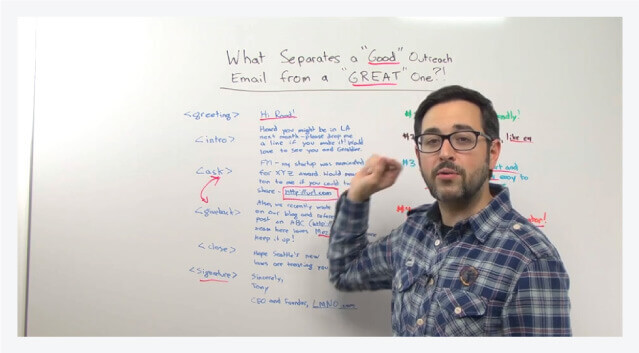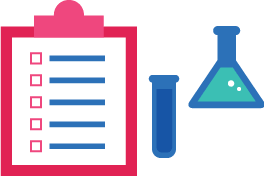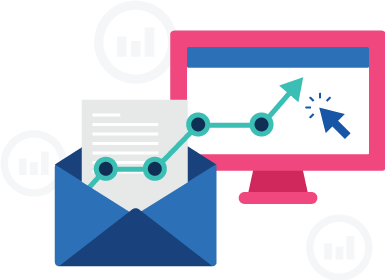The Cold Email Masterclass
Lesson 1
How to Write a Good Email
[lyte id=”ZoECr5_mciU” /]
You’ve probably written thousands of email messages in your life… so why are your cold sales emails falling flat?
What Most People Get Wrong with Email
When you’re writing a cold sales email, you’re trying to get somebody to do something. For that appeal to be effective, your message needs to be structured in a compelling way.
Here’s where most people go wrong:

- Their messages are too long. Everyone’s busy these days. Messages that are too long just won’t get read.
- They fail to capture their prospects’ attention. You have seven seconds (maybe less) to make a first impression. Don’t waste this opportunity with boring, unengaging email copy.
- They don’t personalize at all. Adestra’s 2016 State of Digital Personalization report attributed a 75% higher email click-through rate to email personalization. Yet, despite this, some salespeople still fail to use any personalization at all, placing them behind the curve of what’s possible with today’s cold emailing technology.
- They go overboard with personalization. Inserting merge fields into your message isn’t a substitute for understanding the personalized needs of your prospects and what they need to hear from you to take action. Use personalization wisely and sparingly. Focus more on the needs of your customers than on including every possible merge field.
- They try to do too much with single message. Multiple calls-to-action (CTA), images or links to recommended resources distract prospects and prevent them from taking any action. Keep your initial ask easy and friction-free.
A Better Approach to Writing Cold Emails
Getting cold email right doesn’t have to be complicated.
By outlining your thoughts and choosing a proven template, you can simplify the process of cold emailing and improve your results at the same time.
Start with an Outline

We’ll get into templates in a minute, but to be able to choose the right one, there are a few key pieces of information you need to know.
What’s your ask?
Your first cold email isn’t the right moment to ask for the sale. Just like you wouldn’t propose marriage on a first date, your first cold email should set the stage for a long, productive relationship.
Possible low-friction asks include:
- Viewing a quick video
- Sharing a link or resource socially
- Arranging time for a demo
- Setting up a time for a call
In a Whiteboard Friday video, Moz founder Rand Fishkin breaks down a successful cold outreach email, including a low-friction ask:

The whole video is worth a watch, but here’s what Rand has to say about the ask:
“This person says, “FYI, my startup was nominated for XYZ award. It would mean a ton to me if you could tweet or share the link.” There’s the link. That’s the ask right there. They’ve done a few very smart things here. They’ve kept the ask short and sweet. This is two sentences, extremely few number of words, very obvious what they want and need.”
They also make it easy for him to act on the ask by providing a clickable link that can be shared quickly.
If you’re cold emailing for sales, a social share may not be top priority for you. But you can take advantage of the same effects described by Rand by:
- Making your ask low-investment
- Making it easy for prospects to take action right away
What’s the benefit?

The other critical piece of information you need to know before planning out your cold email approach is what specific benefit you have to offer the recipient.
To understand your benefit – and to be able to communicate it clearly – you need a few other pieces of information:
- What problems do you solve?
- What makes your product or service special?
- What makes your company unique?
- How have you helped clients who are similar to the prospect you’re about to email?
These aren’t simple questions. Put some serious thought into them before moving forward with cold emailing. Determining your answers ahead of time will make the best way to structure your message clear, whether you write a custom email or use one of the seven sample structures in the next section.
Tip: If you can, try to quantify your benefit. Saying past clients have saved 10 hours per week after implementing your solution is much more compelling than saying they “saved a lot of time”.
7 Structures to Test

Now that you have some idea of what you want to say in your cold email, you don’t have to reinvent the wheel. Instead, test different cold email templates that have been proven to work in order to cut your prep time in half.
I’ve covered seven possibilities below, though this list is by no means exclusive. Choose the structure that seems like the best fit for your target prospect:
- If prospects aren’t likely to have heard of you before, use a structure that leads with attention-getting (such as the AIDA structure)
- If you know your prospects are experiencing a significant pain point your product or service solves, the BAB or PAS structures may be better fits
Don’t like the results you’re seeing? You can always come back to the drawing board and choose another structure to test.
1. Attention-Interest-Desire-Action (AIDA)
This copywriting classic involves four steps:
- Attention : Get your reader’s attention quickly
- Interest : Explain why you think your offering will interest your prospect
- Desire : Grow their desire for your offering
- Action : Show them how to take advantage of it

2. Sujan’s 4-Step Format
I don’t have a cheesy name for this one, but it’s proven successful for me over and over.
Basically, the ideal cold sales email should have 4 sentences:
- Ask a question that identifies a problem they certainly have
- Share how you’ve helped another company solve that problem
- A simple, clear CTA
- A P.S. or email signature with social proof
You might not be able to get your message down to a few sentences, especially if your product or service is complex. Do your best by weeding out anything extra you’ve added that doesn’t meet one of these four needs.

3. Before-After-Bridge (BAB)
Courtesy of Buffer, the before-after-bridge aims to get prospects envisioning exactly how your solution will make their lives better.
This is done in three steps:
- Before : Describe what your reader’s life is like now
- After : Help them picture how your solution makes it better
- Bridge : Show them how you’ll take them from before to after

4. Problem-Agitate-Solve (PAS)
Another structure to test, the problem-agitate-solve cold email template works by tapping into your prospect’s pain points:
- Problem : Describe the current problem your prospect is facing
- Agitate : Emphasize the pain of the problem
- Solve : Share how you’ll help them solve it

5. Praise-Picture-Push (PPP)
Who doesn’t love a compliment? Get on your prospects’ good side from the start with the PPP format:
- Praise : Compliment recipients on a recent achievement or milestone
- Picture : Paint a picture of how your solution will help the prospect achieve even more
- Push : Encourage them to take action on your ask

6. Share a Helpful Resource
This Mailshake template will help you leverage your existing content marketing assets while simultaneously earning the trust of your cold email recipients.
Fill in the blanks with your own resources, based on what you know about the prospect’s needs and pain points:

7. Challenge the Current State
This is a Mailshake template that works by challenging your prospect’s status quo.
As we’re all on the lookout for the “latest and greatest” products, this template piques recipients’ interest by suggesting there may be a better alternative out their for their needs.

Deciding between some of these templates will be easy. If your prospect doesn’t have a recent achievement you can find online, for example, you can’t use the praise-picture-push template. Other decisions will be less clear.
My suggestion? Don’t overthink it. Pick the template that resonates best for you, relative to the information you outlined earlier and test your assumptions using the process described below (and more in Lesson #7).
Tap Into Copywriting Wisdom

Want to become a better cold email writer instantly? Look to ad text copy for inspiration and start thinking like a copywriter.
Much has been published about writing great ad copy, and I won’t rehash it all here. The following resources are great primers if you’re new to both ad text and email copywriting:
- Wordstream: “4 Simple But Powerful Tactics for Writing Compelling Ad Copy“
- Hubspot: “Copywriting 101: 6 Traits of Excellent Copy Readers Will Remember“
- Writtent: “35 Copywriting Tips & Tricks from the Pros“
Cold email copy differs from ad copy in a few ways, but the fundamentals are still the same:
- Focus on your “headline” (in this case, your subject line and opening line)
- Make your ask as compelling as possible
- Use clear language that’s easy to understand
- Match your tone and voice to your audience and your brand’s personality – Don’t be afraid to inject a little personality into your cold emails. Check out this fun example from HustleCon’s Sam Parr:

- Make your message scannable – Avoid “wall of text” syndrome. If your message looks like this…

…Incorporate line breaks, bolded/italicized fonts, and lists until it’s easier to read.

- Build credibility – People want to do business with people they trust. That can be tough pull off in a cold email that’s as short as three sentences.
One opportunity you have is to include content you’ve published in your email signature. Having authoritative resources backing up any claims you make in your message instantly builds credibility.
Here’s mine, which links out to resources I’ve published on Youtube and on my blog:

Another way to build credibility is to share successful past experiences, as in the following example from Groove:

Alex builds credibility by emphasizing that he’s approached similar prospects with the same offer in the past and had great results with it. It’s an effective use of social proof to minimize the friction of moving forward.
If you aren’t sure you’re communicating your point clearly, a second (or third, or fourth) set of eyes never hurts. Having a coworker review your email copy may reveal issues you missed on your own.
Think Like a CRO

I’m going to get technical for a minute. Your goal with cold emails is to get people to take action. Improving your copy or working off a predefined template can help, but you can also look to conversion rate optimization (CRO) for guidance.
CRO is a field of digital marketing that’s concerned with testing landing pages and other web assets so that they perform as well as possible, relative to target metrics you’ve set. We’ll dive into cold email optimization in greater detail later on in Lesson #7, but since you need to keep these principles in mind when planning your campaigns, we’ll touch on them here as well.
Metrics Matter
If you aren’t measuring the success of your cold email messages, you can’t make them better.
After all, if you aren’t measuring something like open rate, how will you know if the changes you make in the future are resulting in more or fewer opens?

Some of the most popular metrics salespeople use in cold email campaigns include the following:
- Open rate
- Link clicks
- Response rate
- Leads generated
- New business generated
All of these are valid metrics, but some are easier to track than others.
If you’re totally new to cold emailing, start with one of the first three. If you have the resources to dedicate to more complex sales analytics tools, you can start digging into leads generated and new business generated.
Pick at least one metric to track now, as the number you choose to watch will influence how you structure and test your campaigns.
Testing Cold Email Campaigns

Remember earlier in this lesson, when I warned you not to overthink choosing your template?
That’s because, in order to make your cold emails as effective as possible, you’ll need to continually test your messages to improve them according to the metric you’ve selected.
Again, we’ll dive deeper into testing in a little bit, and I’ll show you exactly how to structure a cold email testing campaign for best results.
However, you may find it helpful – as you go through the lessons leading up to that – to jot down notes on specific elements you want to test later on.
When it comes time to actually execute your testing campaigns, you’ll be glad to have a list of possibilities at hand already.
Validate Your Target Audiences
One final consideration I want you to keep in mind early on is the question of whether or not you’re sending to the right people.
Knowing who you’re messaging informs everything from the template you choose to the tests you decide to carry out. Simply put, you can’t write a “good” email if you’re sending it to the wrong person.
Tim Soulo of the Ahrefs blog has a great breakdown of the four groups you can mail to as part of an influencer outreach campaign: sharks, big fish, small fish and spawn.
I think these distinctions apply equally as well to sending cold sales emails:

- Sharks are the big names in your industry. They’re the kind of people you’d kill to have as clients, but because they’re so well known, they’re difficult to reach via cold email. You typically need a personal intro or to do something really outstanding to get on their radar.
- The big fish are the people one tier down. They’re not as famous, but they’re still big enough to have an impact on your business. You won’t get their attention with a template email, but you may still be able to connect with a smartly-worded cold message.
- Small fish are one more step down. They have value to add to your business as a customer, but they may not be quite as lucrative or have a large enough following to refer your product or service to others.
- Spawn, in this case, are the bottom feeders, tire-kickers and other time-wasters who don’t have a budget for you (even if they’re more than willing to take up your time or energy).
Focus your cold emailing efforts on your big and small fish. Save time by skipping outreach to sharks and spawn.
We’ll talk about finding these prospects in Lesson #3, but for now, having a rough understanding of the type of prospect you’ll be targeting should help you understand exactly how to structure and write a good cold sales email.